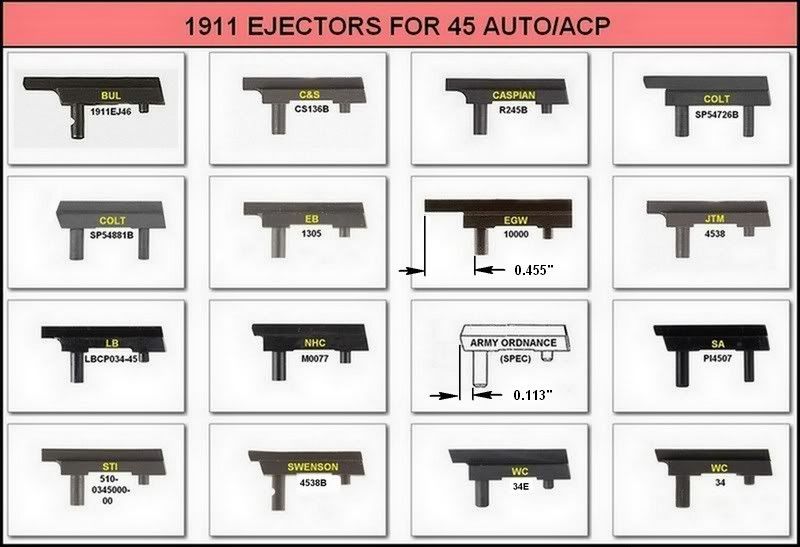I am unsure whether to start this thread in this forum or "The Smithy" forum.
(Mods: feel free to move it if that is more appropriate.)
I would like a well-informed opinion as to the differences between 1911 ejectors: 9mm/.38 Super vs .45 ACP, primarily the width. Explanation below is rather windy, and I apologize for that.
I am entertaining the idea of ordering/obtaining a Mech-Tech 1911 .45 ACP CCU top end for my knock-about 1911. (I am not concerned whether anyone likes this "accessory". I do, albeit it is a somewhat spendy whim.)
http://www.mechtechsys.com/1911.php

The ejector on the intended frame [an "enhanced" (stripped with the ejector and plunger tube installed from the factory) Olympic Arms frame that I used to make a .22 pistol] does not look like the one the Mech-Tech folks recommend. The nose of mine looks similar to the Colt (top row, 4th from the left) or the WC (fourth row, 3rd from left). As far as I have researched, Oly never made 1911 pistols in any other caliber than .45 ACP.
I enquired Mech-Tech if this ejector would work, and here is the response:
I am assuming he is addressing the width (thickness) of the top of the ejector.
Comparing this (my) ejector with the one in my AMT Hardballer .45 (go ahead and laugh), it is about less than 1/32" wider. (The Hardballer ejector looks just like the one Mech-Tech recommends.)
If I am thinking somewhat correctly, the 9mm/.38 Super ejector would have to be wider than the .45 ACP ejector in order for it to contact the case head upon ejection.
To my mind, this flies in contradiction to what the rep told me.
Keep in mind I have never seen or handled a 1911 Mech-Tech CCU so I may be way off base.
Any comments will be appreciated.
Jim
(Mods: feel free to move it if that is more appropriate.)
I would like a well-informed opinion as to the differences between 1911 ejectors: 9mm/.38 Super vs .45 ACP, primarily the width. Explanation below is rather windy, and I apologize for that.
I am entertaining the idea of ordering/obtaining a Mech-Tech 1911 .45 ACP CCU top end for my knock-about 1911. (I am not concerned whether anyone likes this "accessory". I do, albeit it is a somewhat spendy whim.)
http://www.mechtechsys.com/1911.php

The ejector on the intended frame [an "enhanced" (stripped with the ejector and plunger tube installed from the factory) Olympic Arms frame that I used to make a .22 pistol] does not look like the one the Mech-Tech folks recommend. The nose of mine looks similar to the Colt (top row, 4th from the left) or the WC (fourth row, 3rd from left). As far as I have researched, Oly never made 1911 pistols in any other caliber than .45 ACP.
I enquired Mech-Tech if this ejector would work, and here is the response:
The shape is less important in our CCU than the offset. If it is offset the same as a .45 ACP ejector than it should work. The problem we see is if someone tries to put a 9mm CCU on a .45 ACP 1911 frame. Some makes work and others will drag on the breech block.
I am assuming he is addressing the width (thickness) of the top of the ejector.
Comparing this (my) ejector with the one in my AMT Hardballer .45 (go ahead and laugh), it is about less than 1/32" wider. (The Hardballer ejector looks just like the one Mech-Tech recommends.)
If I am thinking somewhat correctly, the 9mm/.38 Super ejector would have to be wider than the .45 ACP ejector in order for it to contact the case head upon ejection.
To my mind, this flies in contradiction to what the rep told me.
Keep in mind I have never seen or handled a 1911 Mech-Tech CCU so I may be way off base.
Any comments will be appreciated.
Jim
